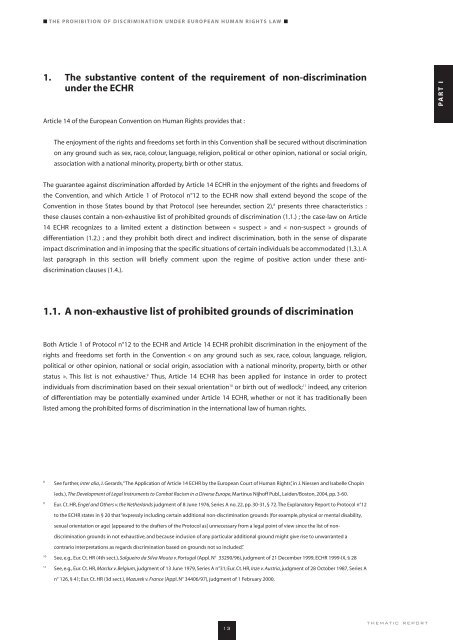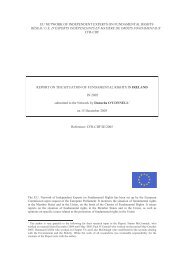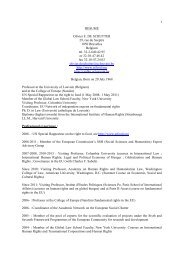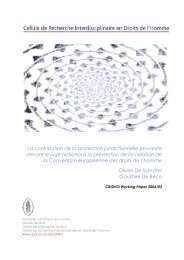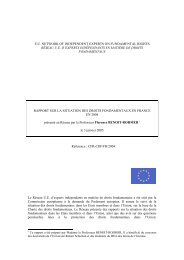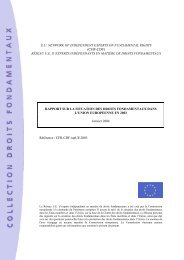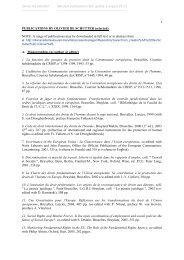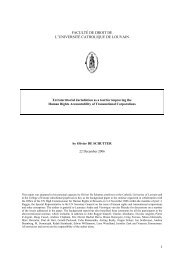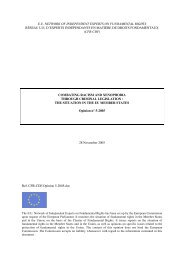The Prohibition of Discrimination under European Human ... - cridho
The Prohibition of Discrimination under European Human ... - cridho
The Prohibition of Discrimination under European Human ... - cridho
Create successful ePaper yourself
Turn your PDF publications into a flip-book with our unique Google optimized e-Paper software.
■ THE PROHIBITION OF DISCRIMINATION UNDER EUROPEAN HUMAN RIGHTS LAW ■<br />
1. <strong>The</strong> substantive content <strong>of</strong> the requirement <strong>of</strong> non-discrimination<br />
<strong>under</strong> the ECHR<br />
Article 14 <strong>of</strong> the <strong>European</strong> Convention on <strong>Human</strong> Rights provides that :<br />
<strong>The</strong> enjoyment <strong>of</strong> the rights and freedoms set forth in this Convention shall be secured without discrimination<br />
on any ground such as sex, race, colour, language, religion, political or other opinion, national or social origin,<br />
association with a national minority, property, birth or other status.<br />
<strong>The</strong> guarantee against discrimination afforded by Article 14 ECHR in the enjoyment <strong>of</strong> the rights and freedoms <strong>of</strong><br />
the Convention, and which Article 1 <strong>of</strong> Protocol n°12 to the ECHR now shall extend beyond the scope <strong>of</strong> the<br />
Convention in those States bound by that Protocol (see here<strong>under</strong>, section 2), 8 presents three characteristics :<br />
these clauses contain a non-exhaustive list <strong>of</strong> prohibited grounds <strong>of</strong> discrimination (1.1.) ; the case-law on Article<br />
14 ECHR recognizes to a limited extent a distinction between « suspect » and « non-suspect » grounds <strong>of</strong><br />
differentiation (1.2.) ; and they prohibit both direct and indirect discrimination, both in the sense <strong>of</strong> disparate<br />
impact discrimination and in imposing that the specific situations <strong>of</strong> certain individuals be accommodated (1.3.). A<br />
last paragraph in this section will briefly comment upon the regime <strong>of</strong> positive action <strong>under</strong> these antidiscrimination<br />
clauses (1.4.).<br />
1.1. A non-exhaustive list <strong>of</strong> prohibited grounds <strong>of</strong> discrimination<br />
Both Article 1 <strong>of</strong> Protocol n°12 to the ECHR and Article 14 ECHR prohibit discrimination in the enjoyment <strong>of</strong> the<br />
rights and freedoms set forth in the Convention « on any ground such as sex, race, colour, language, religion,<br />
political or other opinion, national or social origin, association with a national minority, property, birth or other<br />
status ». This list is not exhaustive. 9 Thus, Article 14 ECHR has been applied for instance in order to protect<br />
individuals from discrimination based on their sexual orientation10 or birth out <strong>of</strong> wedlock; 11 indeed, any criterion<br />
<strong>of</strong> differentiation may be potentially examined <strong>under</strong> Article 14 ECHR, whether or not it has traditionally been<br />
listed among the prohibited forms <strong>of</strong> discrimination in the international law <strong>of</strong> human rights.<br />
8<br />
9<br />
10<br />
11<br />
See further, inter alia, J. Gerards,“<strong>The</strong> Application <strong>of</strong> Article 14 ECHR by the <strong>European</strong> Court <strong>of</strong> <strong>Human</strong> Rights”, in J. Niessen and Isabelle Chopin<br />
(eds.), <strong>The</strong> Development <strong>of</strong> Legal Instruments to Combat Racism in a Diverse Europe, Martinus Nijh<strong>of</strong>f Publ., Leiden/Boston, 2004, pp. 3-60.<br />
Eur. Ct. HR, Engel and Others v. the Netherlands judgment <strong>of</strong> 8 June 1976, Series A no. 22, pp. 30-31, § 72.<strong>The</strong> Explanatory Report to Protocol n°12<br />
to the ECHR states in § 20 that “expressly including certain additional non-discrimination grounds (for example, physical or mental disability,<br />
sexual orientation or age) [appeared to the drafters <strong>of</strong> the Protocol as] unnecessary from a legal point <strong>of</strong> view since the list <strong>of</strong> nondiscrimination<br />
grounds in not exhaustive, and because inclusion <strong>of</strong> any particular additional ground might give rise to unwarranted a<br />
contrario interpretations as regards discrimination based on grounds not so included”.<br />
See, e.g., Eur. Ct. HR (4th sect.), Salgueiro da Silva Mouta v. Portugal (Appl. N° 33290/96), judgment <strong>of</strong> 21 December 1999, ECHR 1999-IX, § 28<br />
See, e.g., Eur. Ct. HR, Marckx v. Belgium, judgment <strong>of</strong> 13 June 1979, Series A n°31; Eur. Ct. HR, Inze v. Austria, judgment <strong>of</strong> 28 October 1987, Series A<br />
n° 126, § 41; Eur. Ct. HR (3d sect.), Mazurek v. France (Appl. N° 34406/97), judgment <strong>of</strong> 1 February 2000,<br />
13<br />
thematic report<br />
PART I


